
Word Count: 125596
(Note: This resource's metadata has been created automatically by reformatting and/or combining the information that the author initially provided as part of a bulk import process.)

Word Count: 125596
(Note: This resource's metadata has been created automatically by reformatting and/or combining the information that the author initially provided as part of a bulk import process.)
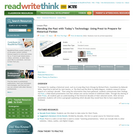
To prepare for literature circles featuring historical novels, students research the decades of the 1930s to the 1990s and share their information using Prezi, a web application for creating multimedia presentations.
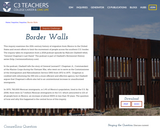
This inquiry examines the 20th century history of migration from Mexico to the United States and recent efforts to limit the movement of people across the southern U.S. border. The inquiry takes its inspiration from a 2018 podcast episode by Malcom Gladwell titled, “General Chapman’s Last Stand.” The podcast is part of Gladwell’s Revisionist History series (http://revisionisthistory.com). In the podcast, Gladwell tells the story of General Leonard F. Chapman Jr., Commandant of the Marine Corps during the Vietnam War, who went on to serve as the Commissioner of the Immigration and Naturalization Service (INS) from 1972 to 1975. Chapman is credited with reforming the INS into a more efficient and effective agency, but Gladwell argues that Chapman’s efforts also led to an unintentional increase in unauthorized immigrants. In 1970, 760,000 Mexican immigrants, or 1.4% of Mexico’s population, lived in the U.S. By 2008, there were 12.7 million Mexican immigrants in the U.S. which amounted to 11% of all people born in Mexico; an increase of almost 800% in less than 30 years. The question of how and why this happened is the central focus of this inquiry.
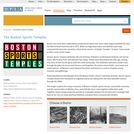
Boston Sports Temples celebrates the rich histories of Bostons professional stadiums and arenas. Some, like Fenway Park, still welcome fans today. Others were demolished decades ago, leaving only hints of their former glory amid the urban landscape. This exhibition welcomes modern fans through the gates of venues both famous and forgotten: the various home fieldsand courts and tracks and iceof Bostons most beloved franchises and hosts to a century of public events, concerts, and gatherings. Featuring historical photographs from the Boston Public Librarys extensive archives, Boston Sports Temples draws from thousands of negatives and prints dating from the early twentieth century through the 1960s. The images capture the unique character of Bostons historic sports venues, memorable moments, and the communities of athletes, fans, and staff who have come together within their walls. Together, these vintage materials provide an invaluable window into the past and a nostalgic look back at our city, our deep sporting traditions, and generations of passionate fandom. Created by the Boston Public Library.

This unit focuses on underreported stories of migration and the local history of everyday people of the City of Newark. From the global stories of women migrants on the move to the wards of the City of Newark, we will examine the experiences of the people who live and inhabit these places and spaces, and who also make history.
Far too often we solely focus on major reported stories related to migration from the point of view of the elite, those in power, or the victors who wrote down their version of history for posterity. This unit seeks to reclaim history for those who resisted, suffered, lost yet triumphed. Anchored by Pulitzer Center migration resources, this unit explores the intersection of the history of the City of Newark (aka Brick City) and global migration using a variety of historical documents, texts, and visuals in which everyday people and the disenfranchised occupy an important space of representation.
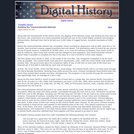
Brief history of the building of the Transcontinental Railroad in the United States.
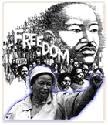
This resource contains some powerpoint slides, google slides, videos, images and worksheets that focus on the civil society protests. It is for specifically designed for Grade 12 learners.
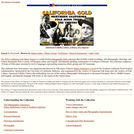
This is a multi-format ethnographic field collection project, undertaken during the New Deal, that includes sound recordings, still photographs, drawings, and written documents from a variety of European ethnic and English- and Spanish-speaking communities in Northern California.

How Canadian Prime Ministers have Responded to Crises at Home and Abroad
Short Description:
A leader’s choices in the way they respond to a crisis can significantly shape the direction of the nation. This book examines various Prime Ministers through their management of crises.
Long Description:
Throughout our course titled Studies in Canadian Political History: Prime Ministers, Leadership, and Managing the Nation, we conceded that a leader’s choices in the way they respond to a crisis can significantly shape the direction of the nation. How a Prime Minister manages a crisis or a particular adversity not only provides a glimpse into the abilities and effectiveness of the leader, but also defines for citizens of a nation — and those observing from a distance outside the national boundaries– what values are being upheld. Each student who has contributed to this book has chosen how one Prime Minister – from John A. Macdonald to Justin Trudeau – reacted to a crisis during their time in office, and how their decisions and leadership choices played a role in shaping Canada’s identity.
Word Count: 77769
ISBN: 978-0-7731-0791-5
(Note: This resource's metadata has been created automatically by reformatting and/or combining the information that the author initially provided as part of a bulk import process.)
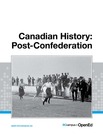
Short Description:
This textbook introduces aspects of the history of Canada since Confederation. “Canada” in this context includes Newfoundland and all the other parts that come to be aggregated into the Dominion after 1867. Much of this text follows thematic lines. Each chapter moves chronologically but with alternative narratives in mind. What Aboriginal accounts must we place in the foreground? Which structures (economic or social) determine the range of choices available to human agents of history? What environmental questions need to be raised to gain a more complete understanding of choices made in the past and their ramifications?
Long Description:
This textbook introduces aspects of the history of Canada since Confederation. “Canada” in this context includes Newfoundland and all the other parts that come to be aggregated into the Dominion after 1867. Much of this text follows thematic lines. Each chapter moves chronologically but with alternative narratives in mind. What Aboriginal accounts must we place in the foreground? Which structures (economic or social) determine the range of choices available to human agents of history? What environmental questions need to be raised to gain a more complete understanding of choices made in the past and their ramifications?
Each chapter is comprised of several sections and some of those are further divided. In many instances you will encounter original material that has been contributed by other university historians from across Canada who are leaders in their respective fields. They provide a diversity of voices on the subject of the nation’s history and, thus, an opportunity to experience some of the complexities of understanding and approaching the past. Canadian History: Post-Confederation includes Learning Objectives and Key Points in most chapter sections, intended to help identify issues of over-arching importance. Recent interviews with historians from across Canada have been captured in video clips that are embedded throughout the web version of the book. At the end of each chapter, the Summary section includes additional features: Key Terms, Short Answer Exercises, and Suggested Readings. The key terms are bolded in the text, and collected in a Glossary in the appendix.
Word Count: 349336
ISBN: 978-1-989623-13-8
(Note: This resource's metadata has been created automatically by reformatting and/or combining the information that the author initially provided as part of a bulk import process.)
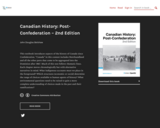
Short Description:
This textbook introduces aspects of the history of Canada since Confederation. “Canada” in this context includes Newfoundland and all the other parts that come to be aggregated into the Dominion after 1867. Much of this text follows thematic lines. Each chapter moves chronologically but with alternative narratives in mind. What Indigenous accounts must we place in the foreground? Which structures (economic or social) determine the range of choices available to human agents of history? What environmental questions need to be raised to gain a more complete understanding of choices made in the past and their ramifications?
Long Description:
This textbook introduces aspects of the history of Canada since Confederation. “Canada” in this context includes Newfoundland and all the other parts that come to be aggregated into the Dominion after 1867. Much of this text follows thematic lines. Each chapter moves chronologically but with alternative narratives in mind. What Indigenous accounts must we place in the foreground? Which structures (economic or social) determine the range of choices available to human agents of history? What environmental questions need to be raised to gain a more complete understanding of choices made in the past and their ramifications?
Each chapter is comprised of several sections and some of those are further divided. In many instances you will encounter original material that has been contributed by other university historians from across Canada who are leaders in their respective fields. They provide a diversity of voices on the subject of the nation’s history and, thus, an opportunity to experience some of the complexities of understanding and approaching the past. Canadian History: Post-Confederation includes Learning Objectives and Key Points in most chapter sections, intended to help identify issues of over-arching importance. Recent interviews with historians from across Canada have been captured in video clips that are embedded throughout the web version of the book. At the end of each chapter, the Summary section includes additional features: Key Terms, Short Answer Exercises, and Suggested Readings. The key terms are bolded in the text, and collected in a Glossary in the appendix.
Word Count: 352702
ISBN: 978-1-77420-065-0
(Note: This resource's metadata has been created automatically by reformatting and/or combining the information that the author initially provided as part of a bulk import process.)

Short Description:
Note: The second edition of this book was published October 2020. You can find it here: Canadian History: Pre-Confederation - 2nd Edition. Canadian History: Pre-Confederation is a survey text that introduces undergraduate students to important themes in North American history to 1867. It provides room for Aboriginal and European agendas and narratives, explores the connections between the territory that coalesces into the shape of modern Canada and the larger continent and world in which it operates, and engages with emergent issues in the field.
Long Description:
Canadian History: Pre-Confederation is a survey text that introduces undergraduate students to important themes in North American history to 1867. It provides room for Aboriginal and European agendas and narratives, explores the connections between the territory that coalesces into the shape of modern Canada and the larger continent and world in which it operates, and engages with emergent issues in the field. The material is pursued in a largely chronological manner to the early 19th century, at which point social, economic, and political change are dissected. Canadian History: Pre-Confederation provides, as well, a reconnaissance of historical methodology and debates in the field, exercises for students, Key Terms and a Glossary, and section-by-section Key Points. Although this text can be modified, expanded, reduced, and reorganized to suit the needs of the instructor, it is organized so as to support learning, to broaden (and sometimes provoke) debate, and to engage students in thinking like historians. Written and reviewed by subject experts drawn from colleges and universities, this is the first open textbook on the topic of Canadian history.
Word Count: 240845
ISBN: 978-1-7753524-1-9
(Note: This resource's metadata has been created automatically by reformatting and/or combining the information that the author initially provided as part of a bulk import process.)
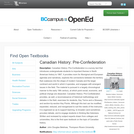
Canadian History: Pre-Confederation is a survey text that introduces undergraduate students to important themes in North American history to 1867. It provides room for Aboriginal and European agendas and narratives, explores the connections between the territory that coalesces into the shape of modern Canada and the larger continent and world in which it operates, and engages with emergent issues in the field. The material is pursued in a largely chronological manner to the early 19th century, at which point social, economic, and political change are dissected. Canadian History: Pre-Confederation provides, as well, a reconnaissance of historical methodology and debates in the field, exercises for students, Key Terms and a Glossary, and section-by-section Key Points. Although this text can be modified, expanded, reduced, and reorganized to suit the needs of the instructor, it is organized so as to support learning, to broaden (and sometimes provoke) debate, and to engage students in thinking like historians. Written and reviewed by subject experts drawn from colleges and universities, this is the first open textbook on the topic of Canadian history.
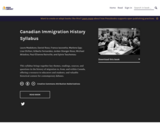
Short Description:
This syllabus brings together key themes, readings, sources, and questions in the history of migration to, from, and within Canada, offering a resource to educators and students, and valuable historical context for contemporary debates.
Long Description:
This syllabus brings together key themes, readings, sources, and questions in the history of migration to, from, and within Canada, offering a resource to educators and students, and valuable historical context for contemporary debates. It is inspired by the example of the #ImmigrationSyllabus created by migration historians in the United States in 2017. Please feel free to share, download, and print this syllabus, or otherwise incorporate it into your teaching and immigration history related work. Wherever possible we have tried to use and link to free, open-access readings and resources. Authors & coordinators: Daniel Ross and Laura Madokoro Collaborators/advisory group: Michael Akladios, Lisa Chilton, Marlene Epp, Gilberto Fernandes, Franca Iacovetta, Paul-Étienne Rainville, Jordan Stanger-Ross, Sylvie Taschereau
Word Count: 5922
ISBN: 978-1-9990201-4-9
(Note: This resource's metadata has been created automatically by reformatting and/or combining the information that the author initially provided as part of a bulk import process.)
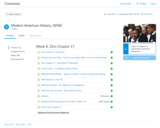
This Canvas shell includes a sample syllabus for a Modern American History course using OER resources. The shell also has two sample modules which include discussion prompts and a sample midterm assignment. Each module has a corresponding announcement that would be sent out at the beginning of the week to remind the students of the work to be done.
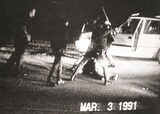
The LA riots of 1992 were a pivotal moment in American history. Not only did they raise awareness of issues of police violence related to African Americans in the beating of Rodney King, they were also the first instance when film footage by an ordinary citizen (well before cell phone cameras) would lead to such direct and widespread consequences. Obviously, with those cell phone cameras, such incidents are now reported regularly, with the largest recent consequences being the summer protests of 2020 after the death of George Floyd. For HS students, 30 years ago might seem like ancient history, but they witnessed 2020. This provides an excellent opportunity not only to provide context for an historical event, but also to connect it directly to the world in which they live, and to explore the concepts of continuity and change. This project is designed to not only help students achieve a better understanding of the events of 1992 as an historical event, but also to refine their skills as historians. Finally, in the culminating part of the project, students will be able to evaluate the judgment of USC criminal justice and law professor Jody David Armour’s comment, “Ain’t nothing changed but the year it is.”

Primarily sourced from "Empire's Crossroads: The Caribbean from Columbus to the Present Day" by Carrie Gibson.
Long Description:
The syllabus, slides, examinations, and assignments provided were produced using several sources. They were created with the purpose of imparting, to students, the information and knowledge necessary to earn 3 college credits. Said credits will be awarded upon completion of the HIST277: The Caribbean since Columbus curriculum and with the satisfactory achievement of the course’s objectives; a description of which is provided in the syllabus. These materials were also created to facilitate the instruction of said material as conducted by my fellow instructors, teachers, and professors.
Word Count: 69892
(Note: This resource's metadata has been created automatically by reformatting and/or combining the information that the author initially provided as part of a bulk import process.)
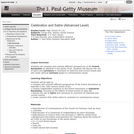
Students will compare and contrast different perspectives of the French Revolution as depicted in two works of art. Students will discuss the use of satire and caricature to comment on historical and current events and will create satirical cartoons based on contemporary issues.
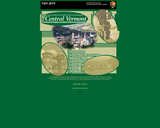
explores Central Vermont's history using 43 historic places that recall past eras when numerous small villages grew slowly until the coming of the railroad, which resulted in a period of rapid growth for Vermont in the last half of the 19th century.
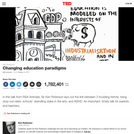
In this talk from RSA Animate, Sir Ken Robinson lays out the link between 3 troubling trends: rising drop-out rates, schools' dwindling stake in the arts, and ADHD. An important, timely talk for parents and teachers.